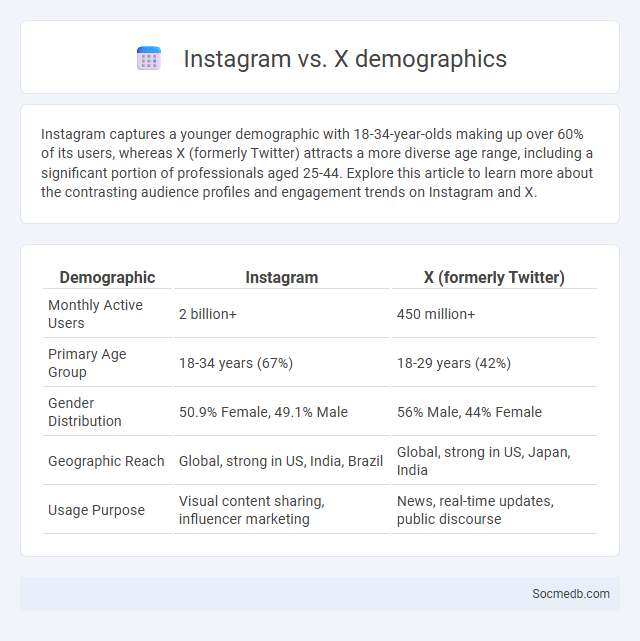
Photo illustration: Instagram vs X demographics
Instagram captures a younger demographic with 18-34-year-olds making up over 60% of its users, whereas X (formerly Twitter) attracts a more diverse age range, including a significant portion of professionals aged 25-44. Explore this article to learn more about the contrasting audience profiles and engagement trends on Instagram and X.
Table of Comparison
| Demographic | X (formerly Twitter) | |
|---|---|---|
| Monthly Active Users | 2 billion+ | 450 million+ |
| Primary Age Group | 18-34 years (67%) | 18-29 years (42%) |
| Gender Distribution | 50.9% Female, 49.1% Male | 56% Male, 44% Female |
| Geographic Reach | Global, strong in US, India, Brazil | Global, strong in US, Japan, India |
| Usage Purpose | Visual content sharing, influencer marketing | News, real-time updates, public discourse |
Introduction to Social Media Demographics
Social media demographics reveal critical insights into user behavior, age distribution, gender ratios, and geographic locations across platforms like Facebook, Instagram, and TikTok. Understanding these patterns helps you tailor content strategies to effectively engage target audiences and improve marketing ROI. Analyzing demographic data ensures your campaigns resonate with the right users for maximum impact.
Overview of Instagram User Demographics
Instagram boasts over 2 billion monthly active users, with a majority aged between 18 and 34, making it a prime platform for reaching millennials and Gen Z. Approximately 50.9% of users are female, while 49.1% are male, showcasing a relatively balanced gender distribution. The platform's global reach extends across key markets like the United States, India, and Brazil, reflecting diverse cultural and economic demographics.
Overview of X (Twitter) User Demographics
X (formerly Twitter) boasts a diverse user base with over 400 million active users worldwide, predominantly aged 18-49, with a significant concentration in urban areas. Around 70% of users access X daily, engaging heavily with news, entertainment, and real-time events. Your ability to target ads and content effectively depends on understanding these demographics, emphasizing younger, tech-savvy professionals and globally connected audiences.
Age Distribution: Instagram vs X
Instagram's user base is dominated by younger demographics, with over 60% of users aged between 18 and 34, making it a prime platform for targeting millennials and Gen Z audiences. In contrast, X (formerly Twitter) attracts a broader age range, with significant engagement from users aged 25 to 49, appealing more to professionals and older millennials. Understanding these age distributions can help you tailor your social media strategy to reach your desired audience effectively.
Gender Breakdown: Comparative Analysis
Social media platforms reveal distinct gender breakdowns, with women dominating visually-driven sites like Instagram and Pinterest, while men tend to be more active on platforms such as Reddit and LinkedIn. Understanding these patterns helps tailor content strategies to engage Your target audience more effectively by aligning messaging with gender-specific preferences and behaviors. Analyzing demographic data from sources like Pew Research Center or Statista provides valuable insights into user distribution, enabling optimized marketing campaigns.
Geographic Locations of Users
Social media platforms attract users from diverse geographic locations, with significant user bases concentrated in North America, Europe, and Asia-Pacific regions. Understanding the distribution of users by country and city enables precise targeting for marketing campaigns and content localization. Your engagement strategies can be enhanced by leveraging location-based analytics to tailor messages that resonate with specific cultural and demographic preferences.
Interests and Online Behaviors
Social media platforms analyze user interests and online behaviors to deliver personalized content and targeted advertisements, enhancing user engagement. Algorithms track activities such as likes, shares, comments, and browsing history to create detailed profiles reflecting preferences in topics, brands, and communities. This data-driven approach allows marketers to optimize campaigns, increase conversion rates, and improve overall user experience by aligning content with individual interests.
Education and Income Levels
Social media usage varies significantly across education and income levels, with higher-educated individuals typically engaging more with professional networks like LinkedIn and accessing educational content. Income levels influence platform preferences and digital literacy, as higher-income users often have greater access to diverse devices and faster internet, enhancing their online experience. These disparities affect the quality and type of information consumed, impacting social mobility and knowledge dissemination.
Brand Engagement: Instagram vs X
Instagram drives higher brand engagement through its visual-centric platform, enabling businesses to showcase products with photos, reels, and stories, resulting in increased likes, comments, and shares. X (formerly Twitter) excels in real-time interaction and conversational marketing, fostering direct customer engagement and swift feedback through tweets and threads. Brands leveraging Instagram benefit from its algorithm favoring visual content, while those on X capitalize on trending topics and hashtag-driven discussions to amplify reach.
Key Takeaways on Social Platform Demographics
Understanding social platform demographics allows you to tailor your content and marketing strategy effectively, targeting specific age groups, interests, and locations. Platforms like Instagram and TikTok attract younger audiences, while Facebook and LinkedIn appeal more to older and professional users, respectively. Monitoring demographic trends ensures your message resonates with the users most likely to engage with your brand.
 socmedb.com
socmedb.com